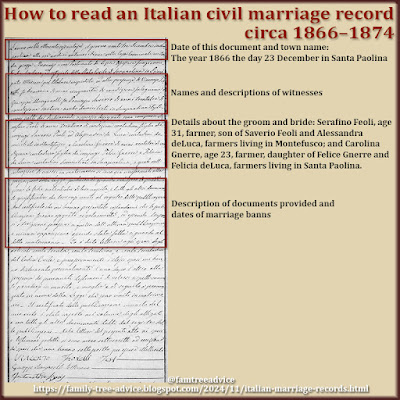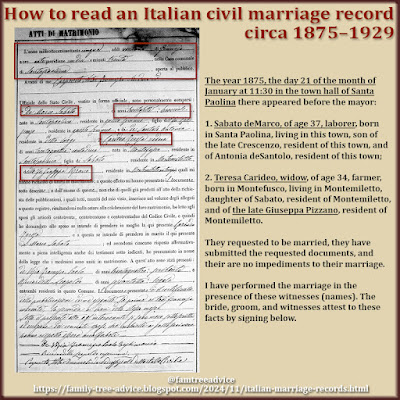Almost eight years ago I wrote an article called How to Read an Italian Death Record. Last week I updated my 8-year-old article on Italian birth records. Today we tackle death records.
For most of my ancestral hometowns, there are no death records online for the years 1861–1930. But I do have one town with all these years, so I'll pull my examples from there.
I've divided the death records into five multi-year phases. Each of the five looks different and presents its information a bit differently. For each phase below, you'll find a simple version of the wording used. Then you'll see a more detailed version and an image highlighting certain key facts.
No matter how the document looks, the death record format boils down to this: Two witnesses came to the mayor and said someone died.
Phase One Civil Death Records, Circa 1809–1811
On many of the earliest death records, the name of the deceased's parents and spouse may be missing. This is awful, but at least it's only for a short time span.
Simple version: Today, on this date there appeared before the mayor of the town two people of this age, profession, and address, and they declare that on this date has died this person, of this age and profession, living in this place.
And having seen with our own eyes that this person is dead, we authorize the church to bury the body after 24 hours.
 |
| The earliest Italian death records contain the least amount of detail about the deceased. |
Detailed version: Today, day (number) of the month of (month) in the year (number), there appeared before the mayor of the town (the name, age, profession, and address of two witnesses declaring the death), and they declared that today at this hour (number) has died (name of deceased), of the age (number) and the profession (profession), who was living in this town on the street (street name).
And having seen with our own eyes that (deceased's name) is dead, we authorize the church to bury the body after 24 hours.
Phase Two Civil Death Records, Circa 1812–1820
Simple version: This year, day, and month, there appeared before the mayor of the town two people of this age, profession, and address, and they declare that on this date in this month has died this person who lived at this place, was married to this person, and was the child of this couple.
The deceased was this age, this profession, lived at this place, and died at this place.
According to the law, we are transferring the body and recording these facts.
 |
| From about 1812 through 1820, Italian death records tell more about the deceased's family. |
Detailed version: In this year (number) on this day (number) of this month (month) at this hour (number), before the mayor in the city hall of the town appeared two men (whose names, ages, professions, and addresses are written out).
They declare that on (date) of (the same) month (deceased's name, spouse of name, child of parents' names), age (number), profession (profession), who lived at (place name) has died at (place name).
According to the law, we are transferring the body and recording these facts.
Phase Three Civil Death Records, Circa 1821–1865
Simple version: This year, day, month, and time, there appeared before the mayor of the town two people who declare that on this date and month has died in their own home this person, and they were married to this person.
The deceased was this age, was born in this place, was of this profession, and lived in this place, and they were the child of this man, of this profession, who lived in this place, and this woman who lived in this place.
According to the law, we are transferring the body and recording these facts.
 |
| From about 1821 through 1865, these records are easier to read and have lots of detail. |
Detailed version: In this year (number), day (number), month (month), and time (number), there appeared before the mayor of the town two men (whose names, ages, professions, and addresses are written out), and they declare that on this date (number) in the month of (month) has died in their own home (deceased's name), and they were married to (spouse's name).
The deceased was this age (number), was born in (place name), of the profession (profession), lived in (place name), they were the child of (father's name), of the profession (profession), who lived in (place name), and (mother's name) who lived in (place name).
According to the law, we are transferring the body and recording these facts.
Phase Four Civil Death Records, Circa 1866–1874
Simple version: This year, day, month, and time, there appeared before the mayor of the town two people who declare that at this time on this date and month has died in their own home this person, of this profession, of this age, who lived in this town and was married to this person. The were born in this place and were the child of this couple.
We present this document and declare this information to be true.
 |
| The handwritten documents from about 1866 through 1874 follow the standard format. |
Detailed version: In this year (number), day (number), month (month), and time (number), there appeared before the mayor of the town two men (whose names, ages, professions, and addresses are written out), and they declare that on this date (number) in the month of (month) has died in their own home (deceased's name), and they were married to (spouse's name).
The deceased was age (number), was born in (place name), of the profession (profession), lived in (place name), they were the child of (father's name) and of the profession (profession), who lived in (place name), and (mother's name) who lived in (place name).
We present this document and declare this information to be true.
Phase Five Civil Death Records, Circa 1875–1945
Simple version: In this year, day, month, and time, there appeared before the mayor of the town two people who declare that at this time on this day and at this address has died this person, of this age, of this profession, who lived in this town, was born in this town, and was the child of this couple, who was [single or married to this person].
Two other witnesses attest to these facts and all declare the facts to be true.
 |
| The more modern Italian birth records, from about 1875 on, are the easiest to read. |
Detailed version: In this year (number), day (number), month (month), and time (number), there appeared before the mayor of the town two people (whose names, ages, professions, and addresses are written out), and they declare that at this time (number) on this day (usually "oggi" for today or "ieri" for yesterday), and at (place name) has died (deceased's name), age (number), profession, who lived in (town name), was born in (town name), child of (father's name, profession, and hometown) and (mother's name, profession, and hometown), who was (single or married to spouse's name).
Note: The word celibe means an unmarried man, while nubile means an unmarried woman.
This testimony is confirmed by (name), age (number), (profession), and (name), age (number), (profession), both living in this town. All present attest to these facts and all declare them to be true.
The same holds true for any vital record in any language. When you know what to expect to see and where to find it, you can harvest the important facts for your family tree.
Don't miss these companion articles:

















